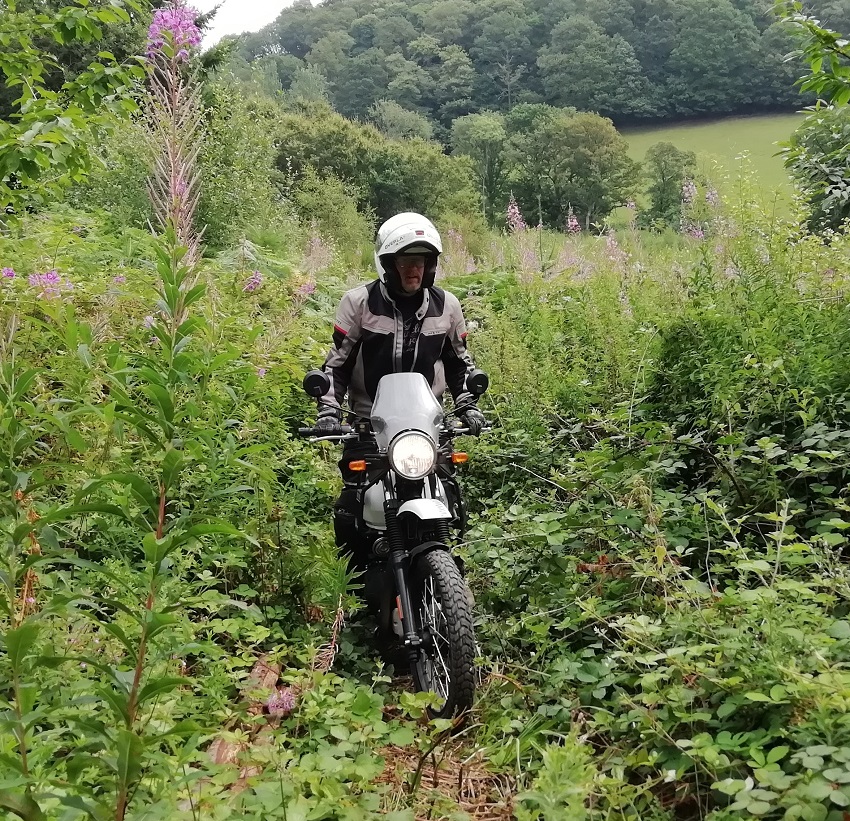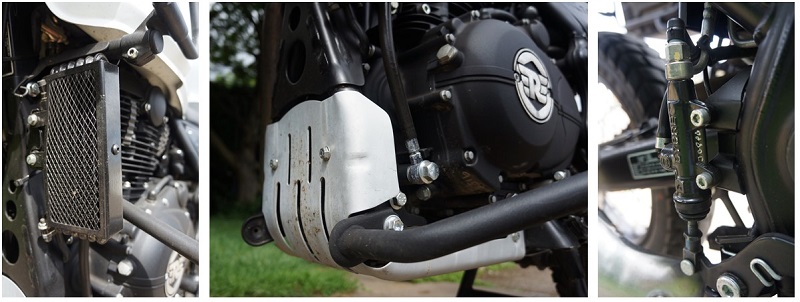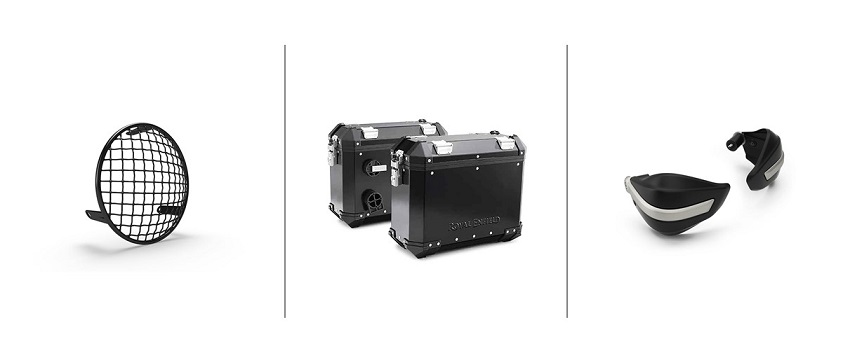It seems you can’t leave your house at the minute without seeing one of Royal Enfield’s Himalayans, but is it just because they retail at under £4k? We’ve only recently collected our long-term test bike but in just under 1,000 miles it’s clear that there is much more to this little machine than the spec sheets suggest.
411cc and 24.5hp? As a full licence holder who would entertain such a thing? Well swallow your prejudices and throw a leg over the 800mm high seat. Put your feet on the low and well positioned footrests, turn that ignition switch and pull the choke lever to start!? I can’t remember the last time I saw one of those for cold starts and this is a fully Euro4 compliant injected bike. But the charm starts right there. Having only collected this white bike at the end of July I’ve had no reason to use the choke as the single cylinder engine fires up immediately and settles into a happy burble.
Engine
Gears are engaged without even the merest jolt, the clutch is smooth and light to operate and the 194kg weight (wet) feels a lot less as you pootle off. Strange to note the clutch cable has no adjustment at the handlebar end. On a country lane this bike is in its element. There is barely a sense there’s an engine beneath you as you whip through the gears because everything is so smooth. The crankcase looks disproportionately large so there must be a host of balance weights or shafts in there. The motor has a long stroke and a single overhead camshaft operating the valves, something that historically signified low revving but high torque characteristics. At 32Nm it’s certainly grunty, but only moderately so. The valves do apparently need adjusting every 3,000 miles, but they are simple screw-and-locknut so that’s no real issue. Whether you’d bother checking that often after the initial bedding-in period is another thing.
Vibration only begins to appear through the seat and ‘bars when the revs approach the 6,500rpm redline. Join an A road and you are initially amazed at the free-revving nature of the bike until you realise just how slowly you are actually going and try to select the non-existent sixth gear. 5,000rpm sees the speedometer needle nudging 65mph. To cross 70 things become uncomfortable.
So don’t do it. There’s no need.

Equipment
Relax and enjoy the beautiful array of instruments behind the little screen, or take a different route. Think about the big journey ahead because in most of the world you won’t be crossing 55mph anyway and this bike is so sweet at that speed. The pleasing instrument cluster contains a cluster of warning lights, a large and easy-to-read speedo and a smaller and not so clear rev counter, both of which are electronic but with sweeping needles. There’s an LCD panel which has a clock, odometer and two trip meters (very handy), a reminder of service intervals, gear indicator, and you can even check on your average speed should you wish to. Then the fun begins.
There’s an air temperature readout that bears no relation to what your body tells you, because the sensor is located above and behind the engine. One early morning I went for my thicker gloves yet apparently it was 34°C when I arrived in town 15 minutes later.

And then there’s the compass, which looks great, but is purely decoration. It’s common to ride on a straight piece of road and watch the direction of travel repeatedly change. Not perhaps flickering between S and SE, but pointing anywhere; N, S, E or W. When it is stable, like during today’s ride from Hereford to Swindon, it told me my direction of travel was continually NE. Use a map.
Ergonomics and Economy
Whatever direction you are headed you’ll find the seat isn’t terribly comfortable. It’s narrow at the front, slopes gently forward and with the pillion seat stepped up behind there is limited room for fore and aft movement. The footpegs as I mentioned, are low and perfectly positioned whether sitting or standing and the ‘bars fall comfortably to hand leaving your back straight. If you can bare the squidgy seat the fuel range is terrific at over 240 miles. The metal tank is slim yet holds 15 litres as it sits above the tall spine of the frame. Its shape is pleasing, but filling it is a slow process due to that high tunnel. Thankfully you won’t do that very often. On test our overall average has been 78.6mpg and you could definitely better that as we have had to use fast roads on occasion. Ignore the fuel gauge though. With the needle well into the red zone there’s often only room for nine litres.

Off the tarmac
I was enjoying the way the Himalayan was suited to country lanes and to the cut and thrust of urban life, with crisp clean fuelling, superb steering lock and light flickable suspension, until I took it off the blacktop at the Trailquest training school in Herefordshire. Off road it seems, is where this little bike excels. It’s simply superb on trails!

Trailquest have been training riders in bike control and expedition preparation for over 15 years and are now Enfield’s official UK training school so it made sense to head there and find out how they’ve found the bikes.
Designed for India, as this bike was, and the conditions experienced there, Royal Enfield seem to have absolutely nailed it. The standard fitment Pirelli MT60 tyres don’t have the most aggressive pattern, but that doesn’t matter. They improve markedly if you let 10lbs of pressure out. It’s a two-minute job to unbolt the rubber inserts from the footpegs, leaving a wider flatter serrated location for your feet, and you are off. The standing position is natural and the transition from sitting couldn’t be easier. That glitch-free fuelling means you can trickle along over rocks and through undergrowth leaving the clutch home. If you feel the need to slip it, one finger is all that’s required for the light cable-operated system.
The Himalayan’s easy to steer through the ‘pegs and the balance and feeling of being planted is better than many more skittish dirt bikes. Of course they might pop wheelies and cover ground more quickly, but you’ll have luggage on and be traversing great distances, hare and tortoise style. The dogged yet competent and confidence-inspiring way this Himalayan tackles loose-surface hills must be commended. It’s never going to perform mono-wheeled antics, but the smile it puts on your face as you push through undergrowth means that doesn’t matter. It seems like it will just keep taking onwards to the next horizon regardless of the terrain.
Chassis and suspension
The ground clearance is an adequate 220mm, there’s a bash plate on the full loop frame so the crankcase should be fine, but the downpipe does look exposed. Interestingly the sump guard isn’t ideally shaped to enable deflection on a rock and could have a shallower angle, but that’s something you can easily rectify. Suspension travel looks reasonable on paper but much of the rear monoshock’s travel is taken up with static sag. It’s so noticeable that using the side-stand leaves the bike almost vertical and you consciously have to find a slope or a hollow to put the stand in. It’s Enfield’s first production bike with a monoshock so quite why it is set-up so badly is a mystery. Thankfully the standard equipment main-stand is a joy to use.

On the road all works well at slow speed but if you do pick up the pace you’ll find that the suspension weaves, and touching white lines or overbanding isn’t enjoyable. I don’t blame the Pirellis for this as I’ve experienced them on many bikes over many miles without this reaction. Again the easiest way to address this issue is to ride at lower speeds where the whole package flourishes.
The disc brakes at both ends are just OK, but they are progressive and have pleasant feel. The calipers themselves are from an Indian subsidiary of Brembo. ABS cannot be switched off but it doesn’t seem overly sophisticated and does permit quite a lot of skidding from the rear which is good, enabling reasonable control on loose descents.

I chose not to have any incidents on the Himalayan, but Trailquest say that thankfully it crashes well and the oil cooler is protected by the standard fitment upper tank guards, which double as mounting points for the accessory bags or fuel canisters. There are aftermarket guards available for rear brake master cylinder and some barkbusters or similar would reduce the risk of bent brake and clutch levers.
Verdict for overlanding
The UK and US are both comparatively tiny markets for Royal Enfield so concerns about the ability to maintain consistent high speeds on highways should be irrelevant. Enfield haven’t failed on that front; they never planned to achieve that in the design. The Himalayan is also remarkable value for money so any minor complaints should always be considered in that context.
It’s built at RE’s newest and most technologically advanced factory just outside Chennai, India but some elements of finish could still be improved. My bike has some rust already showing on messy welds for example and at 1,500miles there appears to be some discernable notching in the head bearings. There are lazily routed wires too, though that may be as a consequence of the way the UK importers have fitted the luggage rack. The electronics in the instruments really shouldn’t be provided just for amusement and there’s no excuse for poor venting on the fuel tank, which causes the bike to consistently groan in hot weather, or the vertical side-stand which can cause the bike to fall over.
Yet the whole package seems to make for a great global travel bike. The technology within the air-cooled engine is very simple. The tank and frame are steel and repairable. It’s frugal. The balance is good and it is so easy to ride it beggars belief, leaving you time to smell the roses and watch the world go by. Perhaps it’s not a bit wonder that so many people seem to have have embraced the charm. And the price.
£3999.00
The not-so-bright colour options include graphite (black), sleet (grey pattern) and snow (white)
Full specifications are available here.
Loads of options are available from Royal Enfield




